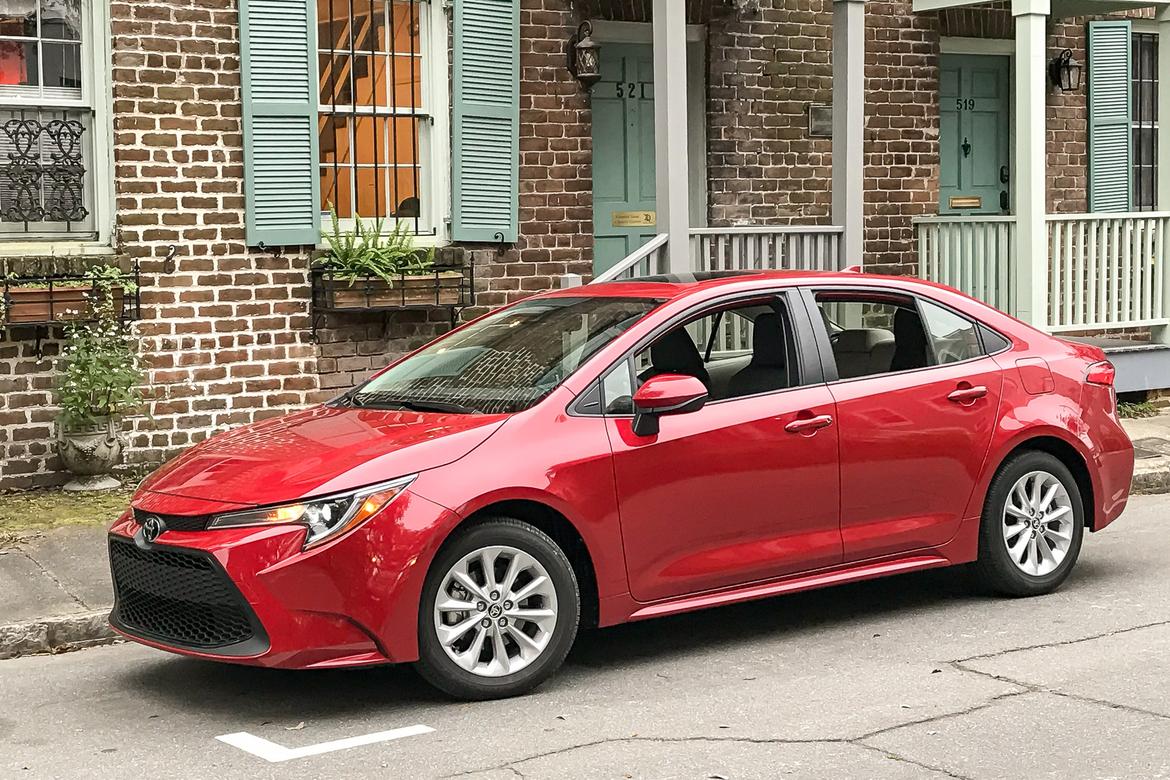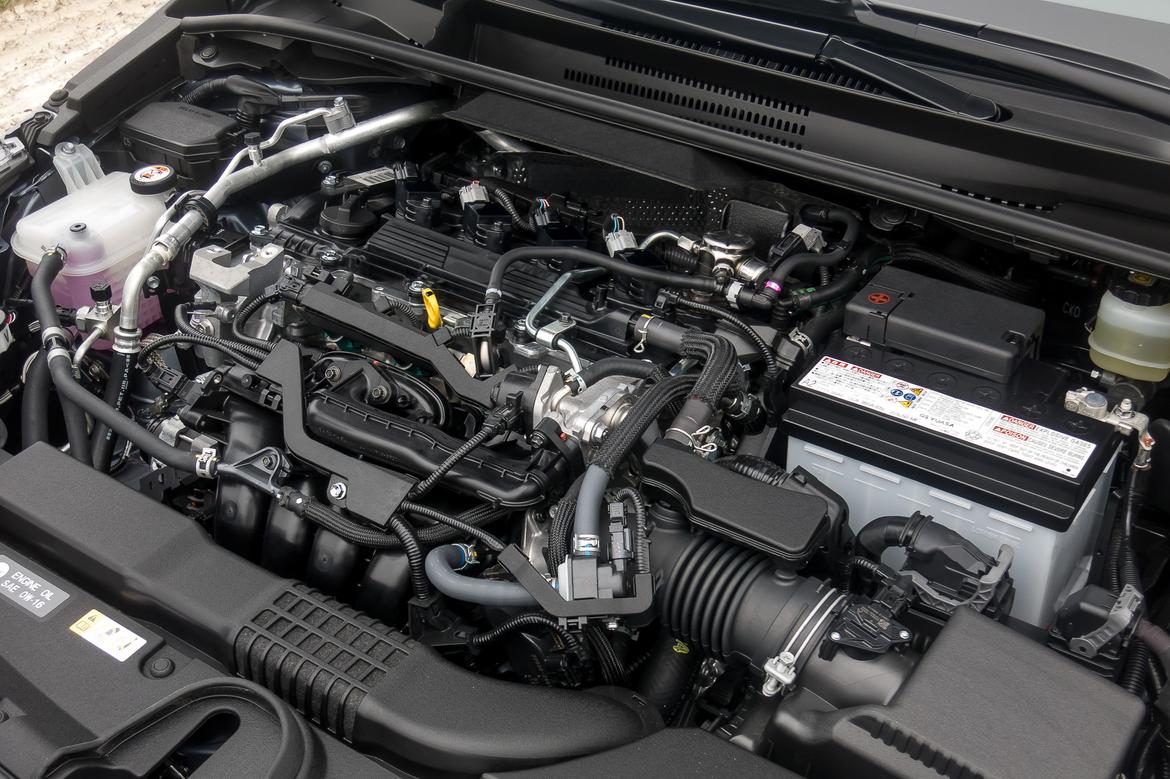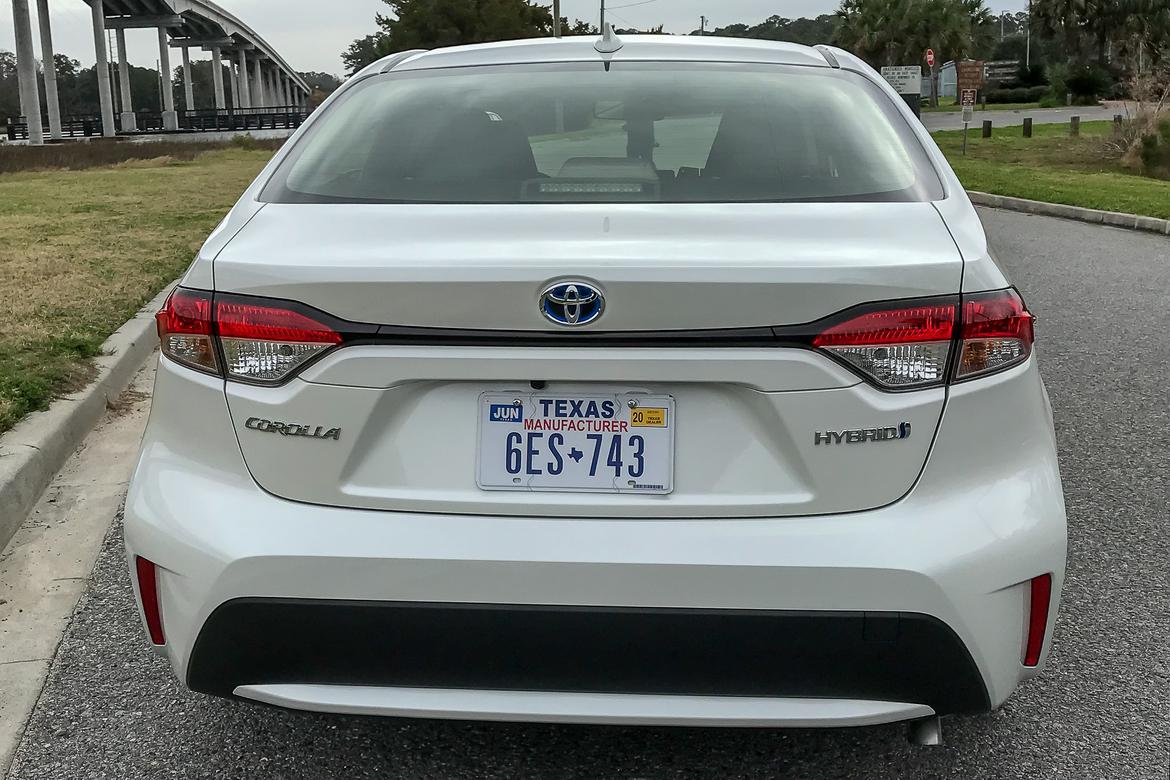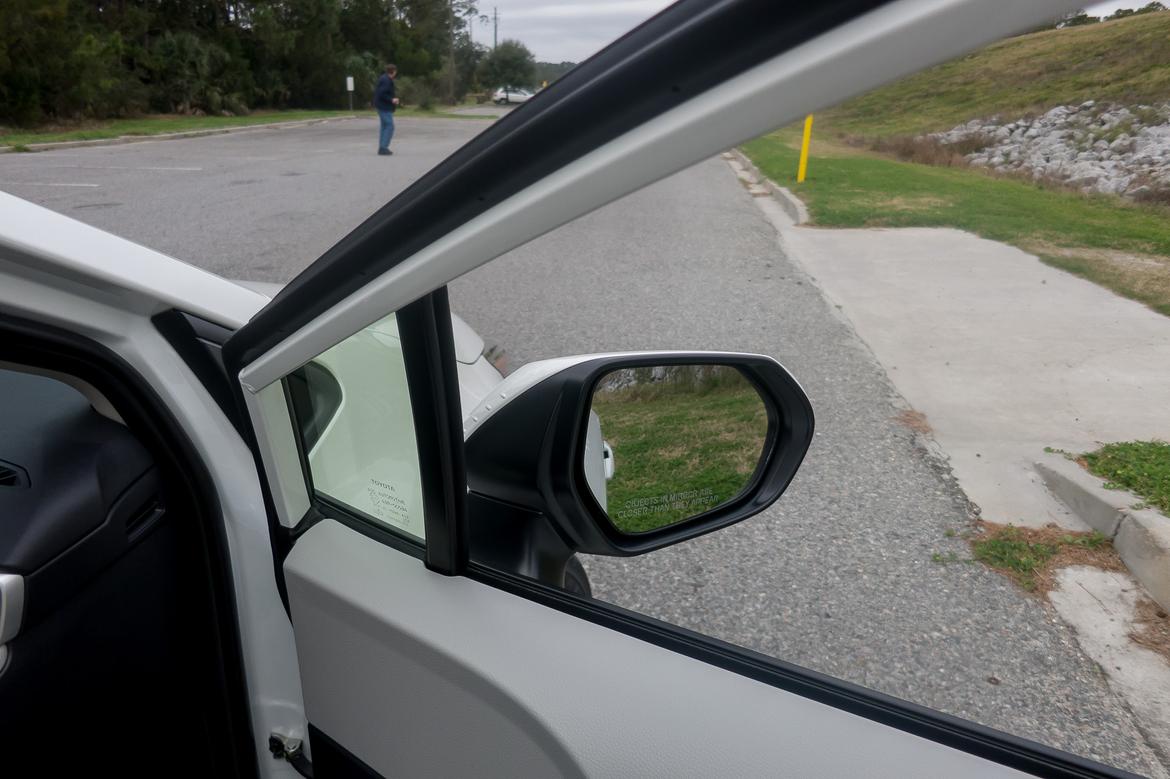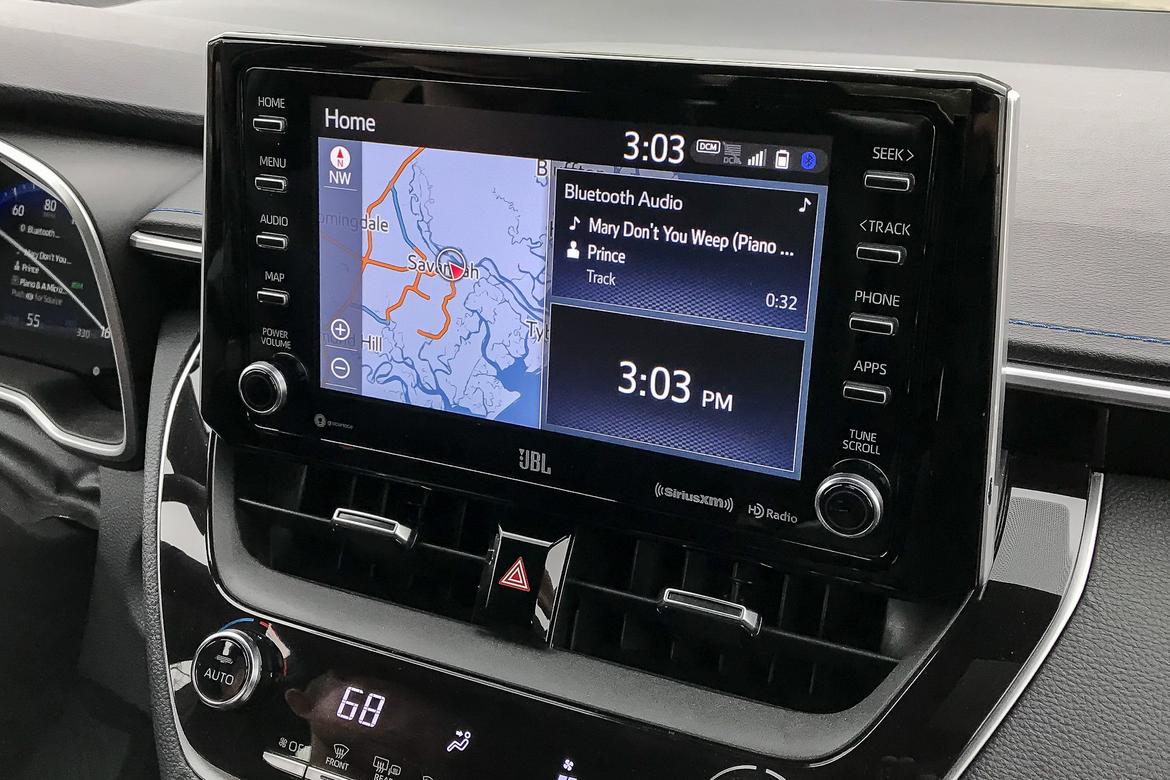We hoped the new 2019 Toyota Corolla Hatchback was a preview of coming attractions for the redesigned 2020 Corolla sedan, and it was. The much-improved sedan now has most of the underpinnings, amped-up tech and design that made the hatchback so appealing. And some versions (but not enough, sadly) also get the hatchback's added zip under the hood.
2019 Toyota Corolla Hatchback Specs & Reviews
Find a 2019 Toyota Corolla Hatchback Near You
The sedan gives up some of the cuteness of the hatch, as well as hatchback cargo versatility, but it adds a backseat for real people and a trunk, which U.S. buyers still favor over a hatch (unless the vehicle in question is an SUV). At least the hatchback's sportier powertrain is available, and the 2020 also arrives with a high-mileage hybrid version using the Prius powertrain.
Corolla sedans have had a well-earned reputation for dependability, but also the emotional appeal of an appliance; my refrigerator sparks more joy. No longer: The redesigned 2020 sedan, like its hatchback sibling, is a Corolla you could want, not just need.
Cars.com photos by Fred Meier
Not that Toyota's compact sedan has wanted for buyers. The Corolla, along with archrival Honda Civic, are the big dogs in that fight, splitting about a third of the segment's annual sales. The redesigned 2020 Corolla hasn't leapfrogged the latest Civic sedan, but now it is competitive in driving manners, tech and refinement.
The 2020 Corolla sedan goes on sale this week in five trim levels: L, LE, SE, XLE and XSE. The new hybrid will be offered only in an LE trim, replacing the LE Eco gasoline model. I drove several versions, including the hybrid, in and around Savannah, Ga., at a Toyota media program. (Per company policy, Cars.com pays for its airfare and lodging at such automaker-hosted events.)
How It Drives
The fun engine choice for the Corolla, only in the sportier SE and XSE trim levels, is the 169-horsepower, 2.0-liter direct-injection four-cylinder that made its debut in the hatchback. It puts out 151 pounds-feet of torque and is mated to the same smart six-speed manual or new-design continuously variable automatic transmission. The CVT's characteristic steel belt does a good job cutting CVT drone, and a physical 1st gear improves pep off the line while lending a more conventional feel to initial acceleration. Paddle shifters let you click through artificial gear steps once the belt takes over. The stick shift (SE only) has an Intelligent Manual Transmission mode with sports-car-like automatic rev-matching on downshifts that also helps match speeds for smoother upshifts and mitigates stalling. I was impressed with the response of the 2.0-liter and CVT (though would still prefer the driving experience of a conventional or dual-clutch automatic), in or out of the Sport driving mode; I did not sample the six-speed in the SE sedan but have found it a ball in the hatchback. My only criticism of either combination is the two-trim availability. The rival Civic sedan puts its 174-hp, turbocharged 1.5-liter in all but the two lowest trim levels.
Cars.com photos by Fred Meier
Sadly, most non-hybrid Corolla buyers will have to make do, even in the loaded XLE, with the ho-hum carryover 1.8-liter four-cylinder that puts out 139 hp (up 7 hp for 2020) and 126 pounds-feet of torque and is mated to a conventional CVT (without the 1st-gear innovation). It will get you there, which may be enough for some Corolla loyalists, but the acceleration is tepid and the old-school engine and CVT are noisier and coarser than the new 2.0-liter combo.
If you need another reason to want the 2.0-liter, how about better gas mileage? The 2020's mileage with the 1.8-liter improved slightly over the 2019, but the new 2.0-liter with the CVT beats it by 1 to 2 mpg. Compare them here. Toyota officials say this is because the new-generation 2.0-liter has improved fuel management and a higher compression ratio; the new CVT also spreads gearing higher.
All Corolla buyers do get a better-handling car that feels more planted on the road and more composed in cornering, with a smoother ride. Like the hatchback, the sedan moves to Toyota's new global platform, which the company says is 60 percent stiffer, and it shows. Also like the hatchback, all 2020 sedans have a multilink, independent rear suspension — an unusual chassis upgrade among mainstream compact sedans — and it adds to the agile feel of the car, with or without the sportier suspension tuning in the SE and XSE trim levels. Standard is Active Corner Assist that uses selective braking to help hold the line in cornering. Steering also has a better weighting, though less so in the LE than in higher trim levels, which Toyota officials said was due to the lower weight and different tires on that version rather than different tuning of the column-mounted electric power assist. Overall, the Corolla may not be the head of the class for handling, but it now is more than competitive with other competent compact sedans.
Corolla Hybrid Is a Prius Some Will Like Better
When is a Prius not a Prius? When it's a Corolla. For 2020, the Corolla replaces the LE Eco with a real-deal Eco, the Corolla LE Hybrid, at the heart of which is Toyota's Prius hybrid powertrain. For now, it is offered only in the second trim level, LE, though Toyota officials indicated that high demand could bring fancier versions. It's priced at $23,880, which is $3,000 more than the gasoline Corolla LE but less than the cheapest Prius, a 2019 Prius L Eco at $24,700. The Corolla's EPA combined mileage rating of 52 mpg equals that of the base Prius. Compare them here.
Cars.com photos by Fred Meier
There are reasons to consider a Prius, including that it's an offbeat hatchback and now offers all-wheel drive. But I'd take the Corolla. It's more enjoyable to drive — quieter, smoother riding and better handling — and the interior and trim now are much nicer.
The Corolla LE Hybrid also would be my pick over a gasoline LE, from which it differs mainly in appearance, with smaller 15-inch wheels, some blue accent trim and hybrid badging. The 121 net system horsepower is comparable and the electric motor's torque assist actually makes it feel peppier off the line. The hybrid powertrain is quieter, particularly under hard acceleration. The hybrid also gains a few features over the conventional LE, such as the 7-inch configurable instrument screen. And the hybrid price premium will be offset over time by the EPA-estimated combined mileage boost of nearly 20 mpg.
The hybrid's regenerative brakes have an unnatural feel and a noticeable transition when the mechanical brakes take over. The hybrid electric-gas transition was seamless, however. The hybrid battery is mounted under the backseat to retain the same rear legroom and 13.1 cubic feet of trunk space, as well as the folding backseat. The backseat base cushion is thinner and more pew than sofa.
Classier Cabin and Amped-Up Tech
The new architecture's thinner front pillars, along with moving the side mirrors onto the doors and adding a small triangle window, significantly improve forward visibility. The interior replaces the previous mishmash of lesser materials with the hatchback's clean design and classier trimmings, including a soft-touch dashboard with piano-black accents even on lower trim levels. And trim quality doesn't drop off markedly in the backseat, which has room for a 6-foot adult to sit behind a 6-foot adult in front. The cabin is quiet with little wind and road noise, particularly in higher trim levels, which get added insulation.
Cars.com photos by Fred Meier
Standard upholstery is cloth. The XLE gets SofTex vinyl, while SE and XSE grades get the most undiluted version of the hatchback interior, with the comfy and supportive sport seats with vinyl trim and color-accented cloth inserts that match the contrast stitching. As before, the only animal leather you'll find in the Corolla is on the steering wheel and shift lever in higher trims.
A touchscreen with volume and tuning knobs and shortcut buttons sits atop the middle of the dashboard. Base L models get the 7-inch screen; all others get an 8-inch screen. Apple CarPlay integration is standard, as is Amazon Alexa, but if you're an Android Auto user, you still are out of luck. You can, however, display navigation on the dash screen via a Scout GPS Link app on your phone. A 4.2-inch driver information display is standard, while a 7-inch configurable instrument display is standard on the XLE, XSE and the hybrid. Two USB ports are standard on all but the L, with one in the center console bin within reach for the rear seat; Wi-Fi capability is standard; wireless charging is newly optional.
Cars.com photos by Fred Meier
Advanced Safety and Driver Aid Tech Standard
All trim levels of the Corolla and Corolla Hybrid have standard a full-featured Toyota Safety Sense 2.0 package of safety and driver assistance technology. It includes a front collision system with automatic braking and pedestrian detection. It also includes a lane departure alert with steering assist, road edge detection, automatic high beams, full-speed adaptive cruise control with stop-and-go (for CVT-equipped models) and road sign detection. Included, too, is a new lane-centering system that proved very good at keeping the car in a marked lane, though it occasionally paused at exit lane splits. Blind spot warning is standard on the higher trim levels and available from the LE up; adaptive headlights are optional on the top two trim levels. The standard safety and driver assistance tech is comparable to the Civic sedan's standard Honda Sensing package and includes more features at more trim levels than the rest of the compact sedan field.
More From Cars.com:
- 2020 Toyota Supra: Second Coming of Supra Answers Enthusiasts' Prayers
- 2019 Toyota Corolla Hatchback Aces Almost All Crash Tests
- Kicking Gas and Taking Names: Which Hybrid Is Better, Camry or Accord?
- Accord Vs. Altima Vs. Camry: Which Is the Best Mid-Size Sedan?
- Which 2019 Honda Civic Trim Level Should I Buy: LX, Sport, EX, EX-L or Touring?
But You'll Have to Pay More for the 2020
The prices are up for every 2020 trim level, though Toyota is quick to point to additional equipment such as standard safety tech. The base L starts $800 higher at $20,430 (all prices here include a $930 destination charge) and includes the CVT automatic. That undercuts a base 2019 Civic LX with automatic at $21,145. The high-volume LE's $20,880 starting price is $815 higher. And the sportier SE with the new engine starts at $22,880 with the CVT and $23,580 with the six-speed manual (which also adds some additional features). They are up $1,305 and $785, respectively.
The XLE is up $1,815 to start at $24,880, the sportier top XSE with the new engine goes up $2,570 to start at $26,380. That pushes the XSE into higher territory and adding the $1,715 premium audio and navigation package totals $28,095, compared with the $28,220 for a top 2019 Civic Touring.
Source: Read Full Article

